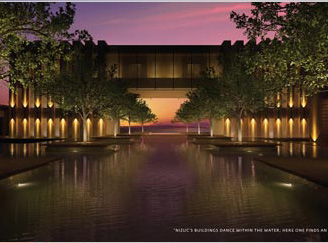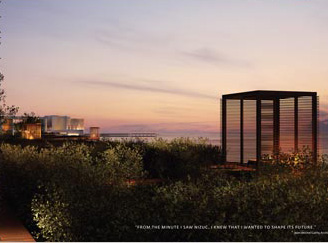A Hotel in Theory, With an Image in Fact
 Fred A. Bernstein - New York Times Fred A. Bernstein - New York Times
go to original


 | | The ads reflect a “brand platform” — the basic ideas from which all other decisions about the hotel would flow. (Archpartners) | | |
Last year, advertisements began appearing in magazines depicting sand, surf and, in one case, a model wearing a mysterious silver amulet.

“A lot of people, when they saw the campaign, thought it wasn’t selling anything,” said Alan Becker, the developer of Nizuc, a resort just south of Cancún, Mexico, where rooms will start at about $800 a night.

But his goal in the campaign was to get the Nizuc name in circulation. The point is to establish a strong brand before the hotel opens for business next year.

In fact, Mr. Becker, who is based in Mexico City, began creating the brand soon after buying Nizuc’s 28-acre site in 2005, and long before he had a hotel operator or an architect on board. (In addition to the 61-room hotel, the property will eventually have more than 150 residences, most of them apartment-style condominiums.)

Generally, an independent hotel developer like Mr. Becker begins a project by choosing an architect, or a hotel chain like Starwood or Marriott, to help determine the look of the building.

According to John Wolf, a spokesman for Marriott International, his company prefers to sign management contracts early in the design process, so that the hotel can be tailored to its standards. A hotel built without the company’s involvement may require renovations before it can be labeled a Marriott, he said.

Mr. Becker tried signing up a management company early, but it didn’t work for him.

In 2005, soon after buying the Nizuc site, Mr. Becker interviewed a half-dozen upscale hotel chains — a process he called “a beauty contest.” But, he said, “we couldn’t agree on a style for the hotel.” The companies, he said, proposed buildings “that had nothing to do with the location.” They were thinking more about their brand identities, he said, than about the site’s special attributes.

Mr. Becker wanted the building to reflect the history of the region, which was an outpost of the Mayan civilization. “We wanted it to be Mayan without being thematic,” he said.

Enter Leslie Smolan and Ken Carbone, partners for 30 years in a Manhattan branding firm, the Carbone Smolan Agency. Their previous jobs have included creating the graphics for the renovated Louvre in Paris and recruiting materials for the Manhattan law firm Skadden, Arps, Slate, Meagher & Flom.

For Mr. Becker, 35, who had never before developed a hotel, they suggested deciding on the basic themes of the hotel, then trying to find a hotel operator who would share their vision.

That began the process of creating what Ms. Smolan called a “brand platform” — the basic ideas from which all other decisions about the hotel would flow. In the case of Nizuc, the theme was “Mayan culture brought into the 21st century.” (The concept leaves enough room for such non-Mayan necessities as sushi.) Once they had established the platform, they promoted the brand not only with print ads, but also with a short film produced at the site.

Mr. Becker would not say how much he paid the branding firm. Ms. Smolan calls her services cost-effective, because, she said, they streamline the rest of the process of creating the hotel.

Mr. Becker agreed. “We spent nine months working to understand, visually and graphically, what were the soul and the feeling we wanted to create,” he said. “Once we did that, it was very easy for everyone involved in the project, from the architect to the landscape architect to the interior designer, to get on board.”

After establishing the brand, Mr. Becker was able to enlist General Hotel Management Ltd., which runs the Setai, a luxury hotel in Miami Beach, and nearly 20 other properties, to operate the Nizuc hotel. G.H.M.’s chairman, Adrian Zecha, a former journalist who is based in Singapore, is best known for creating the high-end Aman Resorts chain.

Mr. Zecha, 75, who spoke by phone from Bali, said part of G.H.M.’S business plan is to operate five-star hotels that have “their own independent identities.” He said Nizuc “fits right in” and praised Mr. Becker’s initiative.

Mr. Becker and his three partners expect to invest $180 million in Nizuc, including the cost of the property (and an adjacent, 22-acre nature preserve), which is shielded from the lights and sounds of Cancún, he said.

The seller was the Mexican government, which had used the waterfront parcel as a presidential retreat — a Mexican Camp David. In 2004, the government decided to auction the land. One of its goals was to spur more high-end hotel development around Cancún, which to many has long been known as a raucous spring-break capital.

Mr. Becker bid $30 million for the land — 40 percent more, he said, than the second-highest bidder.

That might suggest he overpaid for the parcel. But he said he could make back his investment, both from the condos he is building there and from the hotel itself, where nightly prices will range from $800 for a 800-square-foot suite to about $15,000 for a five-bedroom villa. A top-of-the-line Marriott, the J. W. Marriott Cancún Resort and Spa, charges about $250 a night in summer.

To make sure the complex is compelling, Mr. Zecha brought in Jean-Michel Gathy, an architect who has designed many of the G.H.M. and Aman hotels. Nizuc will feature a row of six pools, each set at a different temperature, and cabana-like perches on a jetty built into the Caribbean.

Mr. Gathy, who is based in Malaysia, brought in a number of consultants, including a lighting design company, the Flaming Beacon, from Australia; a landscape designer, Nathan Browning, from Florida; and an interior designer, Jaya Ibrahim, from Indonesia. Mr. Becker said that building the hotel would cost about $79 million, or about $1.3 million for each of the 61 suites.

Mr. Becker concedes that working with Mr. Zecha is expensive, because every item is being custom-made for the hotel. Mr. Zecha’s company charges for its consulting services while the hotel is being built; once the hotel opens, it will receive a management fee.

As for Ms. Smolan, she is trying the branding-first approach again, this time with a former grande dame of a hotel, in Bordighera, on the Italian Riviera. The property, the Hotel Angst (named for its onetime owner Adolph Angst) has been a ruin for years; its new owners, based in Milan, expect to undertake an extensive renovation.

In the meantime, Ms. Smolan said, “there is no architect, no operator, but we’re creating a whole brand.” |



